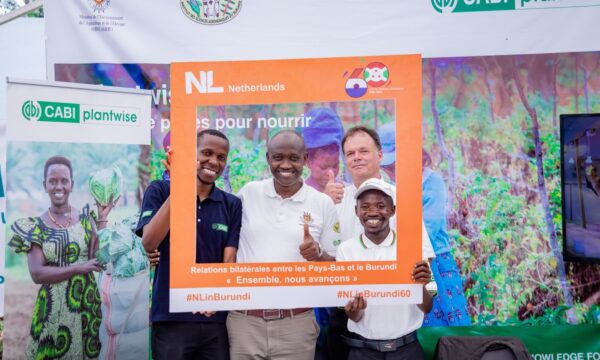
A recent study led by CABI and published in International Journal of Agricultural Sustainability, explores how communication and its technical content shape farmers’ response to advice delivered at plant clinics. How willing were farmers to accept or reject the technologies recommended at plant clinic consultations? And what were the reasons? The research was carried out in Malawi, Costa Rica and Nepal, with the team visiting one plant clinic in each country.

In Malawi, Violet (right) spends a long time listening, and explaining her recommendation to the farmer, Joseph.
Advice given in plant clinics in all three sites was found to be generally clear and open with plant doctors speaking in the local language in a respectful and accessible manner. This was followed up with a written ‘prescription’ which outlined a number of options for a single problem (consistent with IPM principles). This allowed farmers to choose their preferred recommendation, even if it was intended as more of a to-do list rather than a “menu” of choices. The written prescription ensures that the communication is lasting after farmers leave the clinic; not only does it enable farmers to remember the advice but they can also take the prescription to suppliers when buying pesticides. Clinics, therefore were found to have engaged in sound didactic teaching (where the required theoretical knowledge is provided); once the farmers had received their prescription, they were able to subject those recommendations to further environmental learning (e.g. experimenting with new techniques) back home.

A handwritten recommendation in Nepal which can be taken to suppliers.
As extensionists became plant doctors, they had to quickly adapt to diagnosing plant health problems on dozens of crop species and provide sound advice on multiple pests and diseases. This is a huge challenge. Earlier studies indicate that plant clinics did not consistently give accurate diagnoses or recommendations. In this study, there were relatively few misdiagnoses or gross errors of communication. In addition, the plant doctors were able to contact experts to help improve their diagnoses via digital platforms such as WhatsApp or Facebook groups.
Farmer responses to the clinic advice proved too complex to be labelled dichotomous (accept/reject). Their decisions are more nuanced, based generally on the fit of the technology and how well the innovation was communicated. The research did discover problems with the communications and recommended ways in which it could be improved, for example:
- The Plantwise prescription forms include a number of tick boxes which facilitate data input after the consultation. However this is not of much use to the farmers and leaves only a small section for the recommendation. Not all plant doctors remember to write down the diagnosis. The forms could be improved, making them easier to read and printing them in the local language rather than in English.
- Problems with terminology were identified, such as using units of measure (e.g. grams or millilitres) that farmers find difficult to replicate at home without the right equipment. In addition, it was difficult for them to extrapolate further information from this, such as how much they should dilute the chemicals. Measurements must always be communicated in volumes that rural people understand such as a ‘spoonful’ rather than 15ml.

In Costa Rica, Don Gerardo grows ginger
plants under his blackberries to control pests
Farmers learn from other people such as plant doctors or fellow farmers, but in addition, they are also actively experimenting with the advice they receive. Experimenting and learning from others are complementary and is part of the process of developing novel techniques that work for each farmer. What is fundamental for farmers is harvesting a healthy and profitable crop. This means that while the research can ascertain whether technologies were adapted (or not) and why, it doesn’t necessarily define whether the crop problems were actually solved. More research is required to understand not only which options farmers accept from plant clinics but also the extent to which these solved farmers’ problems. As the the research surmises, ‘odds are that farmers temper outsiders’ advice for technical reasons, not because of mis-communication.’
Read Farmer responses to technical advice offered at plant clinics in Malawi, Costa Rica and Nepal in full with open access →
Read the country reports in full, including individual testimonies and photos:
1 Comment
Leave a Reply
Related News & Blogs
How does crop rotation help keep pest populations in control?
Crop rotation is a simple, effective way to manage pests, improve soil health, and boost yields. Suitable for all growers, crop rotation supports sustainable agriculture and reduces the need for chemical inputs. By targeting pest lifecycles and reducin…
6 June 2025





[…] How does communication and its technical content shape farmer responses to plant clinic advice? […]